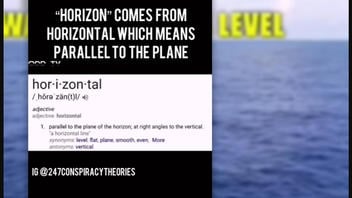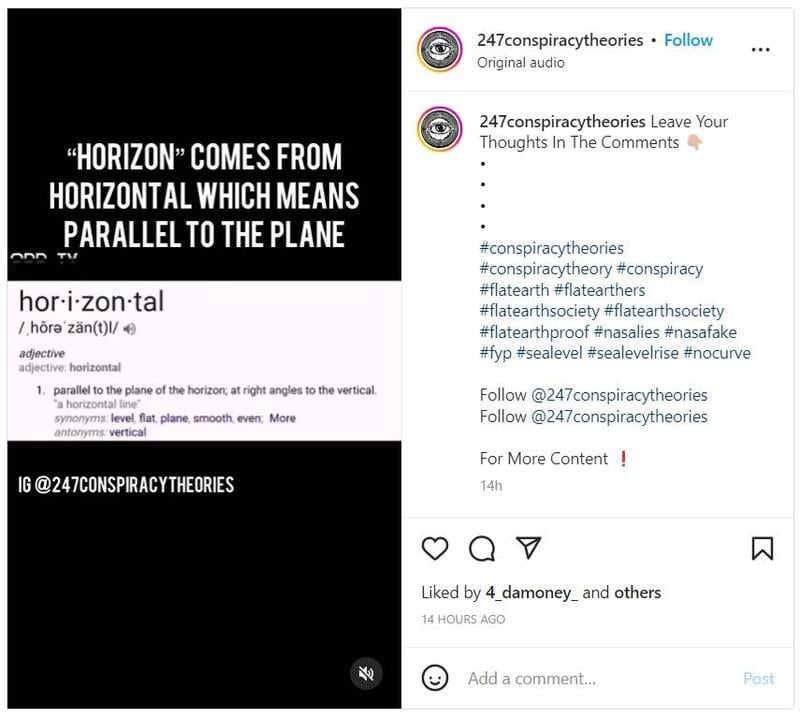
Did the word "horizon" come from the word "horizontal," and is this evidence that the Earth must be flat? No, that's not true: The word "horizon" came first, and the adjective "horizontal" followed. The adjective describes something "relating to or near the horizon." The word "horizon" originated from the ancient Greek term "ὁρίζων κύκλος" (horízōn kýklos), which means "separating (or bounding) circle." The word describes a boundary or separation between Earth and sky, at the farthest limits of view. The shape of planet Earth is an oblate spheroid, a sphere that is slightly squished and wider than it is tall.
The claim appeared in a reel on Instagram on February 22, 2023. It was captioned:
247conspiracytheories
Leave Your Thoughts In The Comments 👇🏼
•
•
•
•
#conspiracytheories #conspiracytheory #conspiracy #flatearth #flatearthers #flatearthsociety #flatearthsociety #flatearthproof #nasalies #nasafake #fyp #sealevel #sealevelrise #nocurveFollow @247conspiracytheories
Follow @247conspiracytheoriesFor More Content ❗️
This is how the post appeared on Instagram at the time of the writing of this fact check:
(Source: Instagram screenshot taken on Thu Feb 23 18:48:35 2023 UTC)
The brief video is bracketed with text that reads:
'HORIZON' COMES FROM HORIZONTAL WHICH MEANS PARALLEL TO THE PLANE
IG@247CONSPIRACYTHEORIES
In the first clip, this definition of "horizontal" is given:
hor-i-zon-tal / hôra zăn(t)l/
adjective
adjective: horizontal
1. parallel to the plane of the horizon; at right angles to the vertical. "a horizontal line"
synonyms: level, flat, plane, smooth, even, More
antonyms: vertical
The narrator says:
Did you know that the word horizon stems from horizontal? The definition of horizontal is as follows: 'parallel to the plane of the horizon; at right angles to the vertical. synonyms: level, flat, plane, smooth, even.' All right? It's called a horizon, not a curvizon.
This argument is based on the false assertion that the adjective "horizontal" defines what the horizon is and limits the shape of the Earth to a flat plane. The adjective simply describes a side-to-side orientation as opposed to vertical; it does not describe the precise shape of the planet.
Language terms, like sunrise and sunset, may figuratively describe how things appear from the perspective of a person, without explaining the literal dynamics of the solar system or universe.
The Online Etymology Dictionary, etymonline.com, reviews the history of the word horizon:
horizon (n.)
late 14c., orisoun, from Old French orizon (14c., Modern French horizon), earlier orizonte (13c.), from Latin horizontem (nominative horizon), from Greek horizon (kyklos) 'bounding (circle),' from horizein 'bound, limit, divide, separate,' from horos 'boundary, landmark, marking stones.' The h- was restored in English 17c. in imitation of Latin. Old English used eaggemearc ('eye-mark') for 'limit of view, horizon.' The apparent horizon is distinguished from the celestial or astronomical horizon.
The second clip in the video shows a large body of water extending to the horizon with no land in sight. A text caption reads:
WATER FINDS IT'S LEVEL
A second narrator says:
Now let's have a look at the characteristics of water. Water always finds its level. And always ends up perfectly flat when undisturbed. It's one of the easiest things to understand. No experiment on Earth has ever replicated curved water like which is supposedly on the spinning ball Earth.
The second claim is also based on the false assertion that water is always perfectly flat when undisturbed. This may be true if observing a glass of water, but, on a planetary scale, the oceans do not "find its level."
The oceans' water is pulled toward the sea floor by Earth's gravity. That water might become level were it not also constantly shifting with tides influenced by the gravitational pull of the moon as well as inertia. This dynamic of the "two bulges" is described by the National Ocean Service:
The gravitational attraction between the Earth and the moon is strongest on the side of the Earth that happens to be facing the moon, simply because it is closer. ... water is pulled toward the moon, causing a 'bulge' of water on the near side toward the moon.
On the opposite side of the Earth, or the 'far side,' the gravitational attraction of the moon is less because it is farther away. Here, inertia exceeds the gravitational force, and the water tries to keep going in a straight line, moving away from the Earth, also forming a bulge ...
Lead Stories has debunked numerous "flat earth" theories and conspiracies in the past. They can be found here.


















